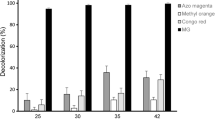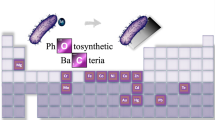Abstract
Tributyl phosphate (TBP) is a toxic organophosphorous compound widely used in nuclear fuel processing and chemical industries. Rhodopseudomonas palustris, one of the most metabolically versatile photosynthetic bacteria, is shown here to degrade TBP efficiently under photosynthetic conditions. This study shows that this O2- and NADPH/FMNH2-dependent process was also catalyzed when TBP was incubated with membrane-associated proteins extracted from this strain. The effects of several regulators of cytochrome P450 activity on the TBP consumption suggest a key role for a cytochrome P450 in this process. Disruption of the rpa0241 gene encoding a putative cytochrome P450 led to a 60% decrease of the TBP catabolism, whereas reintroducing the gene in the mutant restored the wild-type phenotype. The rpa0241 gene was expressed and purified in Escherichia coli. Characterization by UV-visible spectroscopy of the purified recombinant membrane-bound protein (CYP201A2) encoded by the rpa0241 gene revealed typical spectral characteristics of cytochrome P450 with a large spin state change of the heme iron associated with binding of TBP (K d ≈ 65 μM). It is proposed that CYP201A2 catalyzes the initial step of the biodegradation process of TBP.





Similar content being viewed by others
References
Bell SG, Hoskins N, Xu F, Caprotti D, Rao Z, Wong LL (2006) Cytochrome P450) from the metabolically diverse bacterium Rhodopseudomonas palustris. Biochem Biophy Res Commun 342:191–196
Berne C, Montjarret B, Guountti Y, Garcia D (2004) Tributyl phosphate degradation by Serratia odorifera. Biotechnol Lett 26:681–686
Berne C, Allainmat B, Garcia D (2005) Tributyl phosphate degradation by Rhodopseudomonas palustris and other photosynthetic bacteria. Biotechnol Lett 27:561–566
Bhushan B, Trott S, Spain JC, Halasz A, Paquet L, Hawari J (2003) Biotransformation of hexahydro-1,3,5-trinitro-1,3,5-triazine (RDX) by a rabbit liver cytochrome P450: insight into the mechanism of RDX biodegradation by Rhodococcus sp. strain DN22. Appl Environ Microbiol 69:1347–1351
Chapalamadugu S, Chaudhry GR (1992) Microbiological and biotechnological aspects of metabolism of carbamates and organophosphates. Crit Rev Biotechnol 12:357–389
Choi EY, Stockert AL, Leimkuhler S, Hille R (2004) Studies on the mechanism of action of xanthine oxidase. J Inorg Biochem 98:841–848
Cupp-Vickery JR, Poulos TL (1995) Structure of cytochrome P450eryF involved in erythromycin biosynthesis. Nat Struct Biol 2:144–153
Delgoda R, Westlake AC (2004) Herbal interactions involving cytochrome p450 enzymes: a mini review. Toxicol Rev 23:239–249
Guengerich FP (2001) Common and uncommon cytochrome P450 reactions related to metabolism and chemical toxicity. Chem Res Toxicol 14:611–650
Guzman LM, Belin D, Carson MJ, Beckwith J (1995) Tight regulation, modulation, and high-level expression by vectors containing the arabinose PBAD promoter. J Bacteriol 177:4121–4130
Harder PA, O’Keefe DP, Romesser JA, Leto KJ, Omer CA (1991) Isolation and characterization of Streptomyces griseolus deletion mutants affected in cytochrome P-450-mediated herbicide metabolism. Mol Gen Genet 227:238–244
Harwood CS, Gibson J (1988) Anaerobic and aerobic metabolism of diverse aromatic compounds by the photosynthetic bacterium Rhodopseudomonas palustris. Appl Environ Microbiol 54:712–717
Hasemann CA, Ravichandran KG, Peterson JA, Deisenhofer J (1994) Crystal structure and refinement of cytochrome P450terp at 2.3 A resolution. J Mol Biol 236:1169–1185
He K, Talaat RE, Woolf TF (2004) Incorporation of an oxygen from water into troglitazone quinone by cytochrome P450 and myeloperoxidase. Drug Metab Dispos 32:442–446
Heberling S, Girreser U, Wolf S, Clement B (2006) Oxygen-insensitive enzymatic reduction of oximes to imines. Biochem Pharmacol 71:354–365
Hernandez O (2002) SIDS Initial Assessment report for 12th SIAM - Tributyl Phosphate. In: Organization for Economic Cooperation and Development, Paris, France
Ioannides C, Lewis DF (2004) Cytochromes P450 in the bioactivation of chemicals. Curr Top Med Chem 4:1767–1788
Khanna P, Rajkumar B, Jothikumar N (1992) Anoxygenic degradation of aromatic substances by Rhodopseudomonas palustris. Curr Microbiol 25:63–67
Kovach ME, Phillips RW, Elzer PH, Roop RM, Peterson KM (1994) pBBR1MCS: a broad-host-range cloning vector. Biotechniques 16:800–802
Kumar S, Mukerji KG, Lal R (1996) Molecular aspects of pesticide degradation by microorganisms. Crit Rev Microbiol 22:1–26
Laemmli UK (1970) Cleavage of structural proteins during the assembly of the head of bacteriophage T4. Nature 227:680–685
Larimer FW, Chain P, Hauser L, Lamerdin J, Malfatti S, Do L, Land ML, Pelletier DA, Beatty JT, Lang AS, Tabita FR, Gibson JL, Hanson TE, Bobst C, Torres JL, Peres C, Harrison FH, Gibson J, Harwood CS (2004) Complete genome sequence of the metabolically versatile photosynthetic bacterium Rhodopseudomonas palustris. Nat Biotechnol 22:55–61
Lewis DFV (2001) Guide to cytochromes P450—structure and function, Taylor & Francis (eds). Taylor & Francis, London
Leys D, Mowat CG, McLean KJ, Richmond A, Chapman SK, Walkinshaw MD, Munro AW (2003) Atomic structure of Mycobacterium tuberculosis CYP121 to 1.06 A reveals novel features of cytochrome P450. J Biol Chem 278:5141–5147
Michel K, Brinkmann C, Hahn S, Dott W, Eisentraeger A (2004) Acute toxicity investigations of ester-based lubricants by using biotests with algae and bacteria. Environ Toxicol 19:445–448
Nakamura A (1991) International Programme on Chemical Safety - Environmental Health Criteria 112—tri-n-Butyl Phosphate. In: Organisation WH (ed). World Health Organisation, Geneva, Switzerland
O’Keefe DP, Romesser JA, Leto KJ (1988) Identification of constitutive and herbicide inducible cytochrome P-450 in Streptomyces griseolus. Arch Microbiol 149:406–412
Oishi H, Oishi S, Hiraga K (1982) Toxicity of several phosphoric acid esters in rats. Toxicol Lett 13:29–34
Omura T, Sato R (1962) A new cytochrome in rat liver. J Biol Chem 237:1375–1376
Owen S, Jeong BC, Poole PS, Macaskie LE (1992) Tributyl phosphate degradation by immobilized cells of a Citrobacter sp. Appl Biochem Biotechnol 34/35:693–707
Poulos TL, Finzel BC, Howard AJ (1987) High-resolution crystal structure of cytochrome P450cam. J Mol Biol 195:687–700
Raushel FM (2002) Bacterial detoxification of organophosphate nerve agents. Curr Opin Microbiol 5:288–295
Rosenberg A, Alexander M (1979) Microbial cleavage of various organophosphorus insecticides. Appl Environ Microbiol 37:886–891
Rylott EL et al. (2006) An explosive-degrading cytochrome P450 activity and its targeted application for the phytoremediation of RDX. Nat Biotechnol 24:216–219
Schenkman JB, Jansson I (1998) Spectral analyses of cytochromes P450. In: Shephard A (ed) Cytochromes P450 protocols. Humana Press, Totowa, New Jersey, pp 25–33
Seward HE, Roujeinikova A, McLean KJ, Munro AW, Leys D (2006) Crystal structure of the Mycobacterium tuberculosisP450 CYP121-fluconazole complex reveals new azole drug-P450 binding mode. J Biol Chem 281:39437–39443
Singh BK, Walker A (2006) Microbial degradation of organophosphorus compounds. FEMS Microbiol Rev 30:428–471
Stoner D, Tien A (1995) Method and compositions for the degradation of tributyl phosphate in chemical waste mixtures. In: United States Patent. Lockheed Idaho Technologies Company, United States
Suzuki T, Sasaki K, Takeda M, Uchiyama M (1984) Metabolism of tributyl phosphate in male rats. J Agric Food Chem 32:603–610
Thomas RAP, Macaskie LE (1996) Biodegradation of tributyl phosphate by natural occurring microbial isolates and coupling to the removal of uranium from aqueous solution. Environ Sci Biotechnol 30:2371–2375
Thomas RA, Macaskie LE (1998) The effect of growth conditions on the biodegradation of tributyl phosphate and potential for the remediation of acid mine drainage waters by a naturally-occurring mixed microbial culture. Appl Microbiol Biotechnol 49:202–209
Thomas PE, Ryan D, Levin W (1976) An improved staining procedure for the detection of the peroxidase activity of cytochrome P-450 on sodium dodecyl sulfate polyacrylamide gels. Anal Biochem 75:168–176
Thomas RAP, Greated A, Lawlor K, Bailey M, Macaskie LE (1997a) Stabilisation of tributyl phosphate-biodegradative ability of natural-occurring Pseudomonas using ampicillin. Biotechnol Techn 11:781–785
Thomas RAP, Morby AP, Macaskie LE (1997b) The biodegradation of tributyl phosphate by naturally occurring microbial isolates. FEMS Microbiol Lett 155:155–159
Urlacher VB, Lutz-Wahl S, Schmid RD (2004) Microbial P450 enzymes in biotechnology. Appl Microbiol Biotechnol 64:317–325
US EPA (1992) Chemical information collection and data development (testing)—tributyl phosphate test results. In: Agency UEP (ed) http://www.epa.gov/opptintr/chemtest/tributph.htm. US Environmental Protection Agency, Washington, USA
Acknowledgments
This work was supported by the Commissariat à l’Energie Atomique and COGEMA. We thank P. Carrier and Dr. L. Cournac for oxygen consumption measurements.
Author information
Authors and Affiliations
Corresponding author
Rights and permissions
About this article
Cite this article
Berne, C., Pignol, D., Lavergne, J. et al. CYP201A2, a cytochrome P450 from Rhodopseudomonas palustris, plays a key role in the biodegradation of tributyl phosphate. Appl Microbiol Biotechnol 77, 135–144 (2007). https://doi.org/10.1007/s00253-007-1140-4
Received:
Revised:
Accepted:
Published:
Issue Date:
DOI: https://doi.org/10.1007/s00253-007-1140-4




